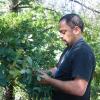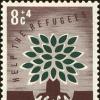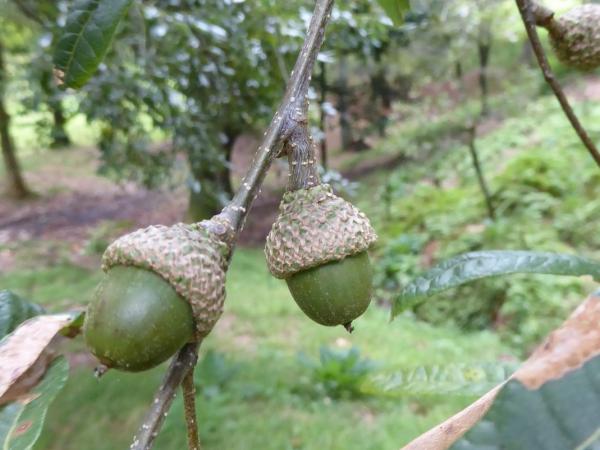Editor's Picks
Plant Focus
Cultivar Close-up: Hi-Yo Silver!
In a tradition that has been traced to medieval Germany and perhaps Ancient Rome, it was customary to celebrate the 25th anniversary of a couple’s wedding by presenting the wife with a wreath made of silver. The quarter-of-a-century anniversary thus came to be known as the Silver Anniversary. Later the same tradition was applied to the anniversary of a monarch’s coronation, where a Silver Jubilee marked 25 years on the throne, or indeed to any entity that reach a 25-year mark. Also part of this custom is the Golden Jubilee, which marks a 50-year anniversary. Other jubilees were added later, mostly associated with gems or metals, in order of increasing value and durability: 40 is ruby, 60 is diamond, and 70 is platinum. The 80-year mark is extra special and goes beyond what precious stones or metals can offer: it is known (how else?) as the Oak Jubilee.

Chevithorne Barton, Devon, UK © James MacEwen
As we celebrate 25 years of the IOS, we take a look at oaks that have an association with silver. In a Species Spotlight, Joeri Strijk describes Quercus argentata (the epithet derives from the Latin word for silver: argentum) and below are three well-known cultivars with silver associations. These might be good choices for a ceremonial planting in honor of the IOS’s 25th, and indeed such a planting occurred during the Oak Open Day in Czech Republic, where a seedling of Quercus ×schuettei ‘Silver Shadow’, a brand new cultivar recently published in International Oaks No. 28, was planted in Plaček Quercetum. Another seedling will also be planted at the Anniversary Celebration at Starhill Forest Arboretum in September.
Quercus macrolepis ‘Hemelrijk Silver’
This cultivar was selected in Hemelrijk, a Belgian garden created by renowned horticulturists Robert and Jelena de Belder. The name of the garden derives from the Flemish words for “heaven” and “kingdom”. Grown from seed collected by the de Belders on the Greek island of Rhodes, the tree has large, bluish-grey leaves, particularly the new growth. This species also has attractive acorns, with conspicuous revolute scales. Much ink has been spilled about whether Q. macrolepis should be ranked as a subspecies of Q. ithaburensis (see Michael Avishai’s Vallonea or Aegilops Oaks, a Short Review), but the cultivar was registered with “macrolepis” as the species epithet, originally as Q. macrolepis ‘Hemelrijk’ in 1996, later amended to ‘Hemelrijk Silver’, so as not to repeat the cultivar name of Q. ellipsoidalis ‘Hemelrijk’, another de Belder selection.

Quercus cerris ‘Argenteovariegata’

Ross-shire, Scotland © Andrew McMillan
The variegation on the leaves of this cultivar of Turkey oak is creamy-white, but the overall effect is a silvery sheen that justifies the name and makes it an attractive and popular selection. The cream-colored edge on the leaves is wide and irregular, and sometimes creamy patches occur or the variegation extends to the central vein. It is readily available in European nurseries and, being relatively resistant to frost, it would be a good choice for collections outside warmer climates (a notable specimen grows in Inverewe Gardens in the Scottish Highlands). It is an old cultivar, thought to have been introduced before 1864. According to The Hillier Manual of Trees and Shrubs, it is a “most effective variegated tree,” though it occasionally produces reverting green shoots that should be promptly removed.


Quercus robur ‘Argentomarginata’
This is also an old cultivar, introduced in 1873, and like Q. cerris ‘Argenteovariegata’, the leaves have irregular white variegation, but to a lesser extent, mostly at the margins but sometimes extending almost to the midrib. An added attraction is that the immature acorns are also variegated, with green and white longitudinal stripes, somewhat like a miniature watermelon. Several other 19th century “argent” cultivars of Q. robur have been registered by the IOS in its role as International Cultivar Registration Authority (e.g., ‘Argentea’, ‘Argenteopicta’, ‘Argenteovariegata’, etc.), but ‘Argentomarginata’ is the one that is more commonly seen in nurseries and collections.
Other argents
A group of horticultural plants collected from Western Texas, originally described by William Trelease under the name Q. sinuata f. argentata, are now known as Q. sinuata var. breviloba Argentata Group. The leaves are more elongated, crisped and deeply lobed, and very silvery beneath. Finally, several of Allan Taylor’s selections of Q. ×undulata have provisionally been given silver-themed names (‘Quick Silver’, ‘Silver Bullet’, and ‘Silver Tip’), but they have not been registered yet.

Grigadale Arboretum, Argentina © Roderick Cameron











